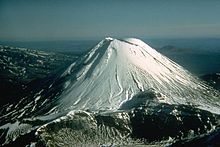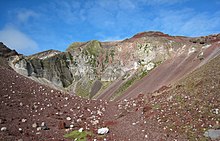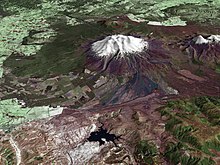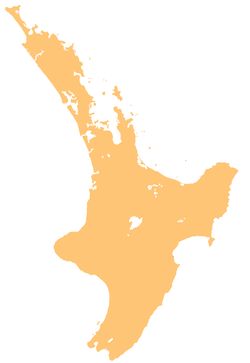Taupō Volcanic Zone
Taupō Volcanic Zone | |
|---|---|
 | |
Location of Taupō Volcanic Zone in New Zealand | |
| Coordinates: 38°40′00″S 176°01′00″E / 38.66667°S 176.01667°E | |
| Location | North Island |
| Age | Miocene - Holocene |
| Formed by | Volcanic action |
| Geology | see Taupō Rift |
| Highest elevation | 2,797 m (9,177 ft) |
The Taupō Volcanic Zone (TVZ) is a volcanic area in the North Island of New Zealand that has been active for at least the past two million years and is still highly active. Mount Ruapehu marks its south-western end and the zone runs north-eastward through the Taupō and Rotorua areas and offshore into the Bay of Plenty. It is part of a larger Central Volcanic Region that extends to the Coromandel Peninsula and has been active for four million years. The zone is contained within the tectonic intra-arc continental Taupō Rift and this rift volcanic zone is widening unevenly east–west with the greatest rate of widening at the Bay of Plenty coast, the least at Mount Ruapehu and a rate of about 8 mm (0.31 in) per year at Taupō. The zone is named after Lake Taupō, the flooded caldera of the largest volcano in the zone, the Taupō Volcano and contains a large central volcanic plateau as well as other landforms.
Activity

There are numerous volcanic vents and geothermal fields in the zone, with Mount Ruapehu, Mount Ngauruhoe and Whakaari / White Island erupting most frequently. Whakaari has been in continuous activity since 1826 if you count such as steaming fumaroles, but the same applies to say the Okataina volcanic centre.[1] The Taupō Volcanic Zone has produced in the last 350,000 years over 3,900 cubic kilometres (940 cu mi) material, more than anywhere else on Earth, from over 300 silicic eruptions, with 12 of these eruptions being caldera-forming.[2] Detailed stratigraphy in the zone is only available from the Ōkataina Rotoiti eruption but including this event, the zone has been more productive than any other rhyolite predominant volcanic area over the last 50,000 odd years at 12.8 km3 (3.1 cu mi) per thousand years.[3]: 230–232 Comparison of large events in the Taupō volcanic zone over the last 1.6 million years at 3.8 km3 (0.91 cu mi) per thousand years with Yellowstone Caldera's 2.1 million year productivity at 3.0 km3 (0.72 cu mi) per thousand years favours Taupo.[3]: 225 Both the Taupō Volcano and the Ōkataina Caldera have had multiple eruptions in the last 25,000 years. The zone's largest eruption since the arrival of Europeans was that of Mount Tarawera (within the Ōkataina Caldera) in 1886, which killed over 100 people. Early Māori would also have been affected by the much larger Kaharoa eruption from Tarawera around 1315 CE.[4][5]
The last major eruption from Lake Taupō, the

Whakaari / White Island had a major, edifice failure collapse of its volcano dated to 946 BCE ± 52 years. It has been suggested that this was the cause of the tsunami tens of metres tall that went up to 7 kilometres (4.3 mi) inland in the Bay of Plenty at about this time. Although significant tsunami's can be associated with volcanic eruptions, it is unknown if the cause was a relatively small eruption of Whakaari or another cause such as a large local earthquake[7]
Taupō erupted an estimated 1,170 km3 (280 cu mi) of DRE material in its
The
Extent and geological context

The Taupō volcanic zone is approximately 350 kilometres (217 mi) long by 50 kilometres (31 mi) wide. Mount Ruapehu marks its southwestern end, while Whakaari / White Island is considered its northeastern limit.[11]
It forms a southern portion of the active
Associated with the Taupō volcanic zone, intra-arc extension is expressed as normal faulting within a zone known as the Taupō Rift.[17] Volcanic activity continues to the north-northeast, along the line of the Taupō Volcanic Zone, through several undersea volcanoes in the South Kermadec Ridge Seamounts, then shifts eastward to the parallel volcanic arc of the Kermadec Islands and Tonga. Although the back-arc basin continues to propagate to the south-west, with the South Wanganui Basin forming an initial back-arc basin, volcanic activity has not yet begun in this region.[18]
South of

Scientific study
Tectonics
In the North Island rifting associated with plate tectonics has defined a Central Volcanic Region, that has been active for four million years and this extends westward from the Taupō volcanic zone through the western Bay of Plenty to the eastern side of the Coromandel Peninsula.[19] The dominant rifting axis associated with the Central Volcanic Region has moved with time, from the back-arc associated Hauraki Rift to the intra-arc Taupō Rift. As there is presently no absolute consensus with regard to the cause of the Taupō Rift's extension or its exceptional current volcanic productivity, some of the discussion on this page has been simplified, rather than all possible models being presented.
Recent scientific work indicates that the Earth's crust below the Taupō Volcanic Zone may be as little as 16 kilometres thick. A film of
The Tauranga Volcanic Centre which was active between 2.95 to 1.9 million years ago, and was previously classified as part of the Central Volcanic Region,[19] appears now to be in a tectonic continuum with the Taupō Volcanic Zone. Recent ocean floor tephra studies off the east coast of the North Island have shown an abrupt compositional change in these, from about 4.5 million years ago, that has been suggested to distinguish Coromandel Volcanic Zone activity from that of the Taupō Volcanic Zone.[23] Further the distinctive Waiteariki ignimbrite that erupted 2.1 million years ago in a supereruption, presumably from the gravity anomaly defined Omanawa Caldera,[24] is within the postulated borders of the old Taupō Rift.[25]
Faults
The multiple intra-rift faults are some of the most active in the country and some have the potential to create over magnitude 7 events. The fault structures are perhaps most well characterised related to the Ruapehu and Tongariro grabens. The recent deposits from major eruptions and lake features mean many potentially significant faults are uncharacterised, either completely (for example the 6.5 MW 1987 Edgecumbe earthquake resulted in the mapping of the Edgecumbe fault for the first time) or frequency of events and their likely magnitude are not understood. It can not be assumed that just because the rate of expansion of the rift is greatest near the coast that this is where most significant tectonic earthquakes in terms of human risk will be. The Waihi Fault Zone south of Lake Taupō and associated with the Tongariro graben has a particular risk of inducing massive landslips which has caused significant loss of life and appears to be more active than many other faults in the zone.
Volcanism

The north (
The central part of the zone is composed of eight caldera centres the oldest of which is the Mangakino caldera which was active more than a million years ago (1.62–0.91 Ma).[26] This produced ignimbrite that 170 km (110 mi) away in Auckland is up to 9 m (30 ft) thick.[33] Other than the now buried Kapenga caldera there are five caldera centres, Rotorua, Ohakuri, Reporoa, Ōkataina and Taupō. These have resulted from massive infrequent eruptions of gaseous very viscous rhyolite magma which is rich in silicon, potassium, and sodium and created the ignimbrite sheets of the North Island Volcanic Plateau. The detailed composition suggests subduction erosion might play a predominant role in producing this rhyolite,[34]: abstract as later assimilation and fractional crystallization of primary basalt magma, is difficult to model to explain the composition and volumes erupted.[35] This central zone has had the largest number of very large silicic caldera-forming eruptions recently on earth as mentioned earlier.[36][3]
During a period of less than 100,000 years commencing with the massive Whakamaru eruption about 335,000 years ago of greater than 2,000 km3 (480 cu mi) dense-rock equivalent of material, just to the north of the present Lake Taupō, over 4,000 km3 (960 cu mi) total was erupted. These eruptions essentially defined the limits of the present central volcanic plateau, although its current central landscape is mainly a product of later smaller events over the last 200,000 years than the Whakamaru eruption. The other volcanic plateau defining eruptions were to the west, the 150 km3 (36 cu mi) Matahina eruption of about 280,000 years ago, the mainly tephra 50 km3 (12 cu mi) Chimp (Chimpanzee) eruption between 320 and 275 ka, the central 50 km3 (12 cu mi) Pokai eruption of about 275 ka, and the paired Mamaku to the north and east central Ohakuri eruptions of about 240,000 years ago that together produced more than 245 km3 (59 cu mi) dense-rock equivalent of material.[36] The southern Taupō Volcano Oruanui eruption about 25,600 years ago produced 530 km3 (130 cu mi) dense-rock equivalent of material and its recent Hatepe eruption of 232 CE ± 10 years had 120 km3 (29 cu mi) dense-rock equivalent.[6] Since the Whakamaru eruption the central part of the zone has dominated, so that when the whole zone is considered there has been about 3,000 km3 (720 cu mi) of rhyolite, 300 km3 (72 cu mi) of andesite, 20 km3 (4.8 cu mi) of dacite and 5 km3 (1.2 cu mi) of basalt erupted.[3]: 228, 231
Less gaseous
The southern part of the zone contain classic volcanic cone structure formed from andesite magma in effusive eruptions that cool to form dark grey lava if gas-poor or scoria if gas-rich of this part of the zone. Mount Ruapehu, the tallest mountain in the North Island, is a 150 km3 (36 cu mi) andesite cone surrounded by a 150 km3 (36 cu mi) ring-plain.[40] This ring plain is formed from numerous volcanic deposits created by slope failure, eruptions, or lahars. Northwest of Ruapehu is Hauhungatahi, the oldest recorded volcano in the south of the plateau,[40] with to the north the two prominent volcanic mountains in the Tongariro volcanic centre being Tongariro and Ngauruhoe which are part of a single composite stratovolcano.
Risks

The most likely risk is earthquake associated with multiple active faults,[41] such as within the Taupō Fault Belt, but many faults will be uncharacterised as was the case with the 1987 Edgecumbe earthquake.[42] Earthquakes can be associated with landslides and inland or coastal tsunami that can result in great loss of life and both have happened on the Waihi Fault Zone.[43] The relative low grade volcanic activity of the andesite volcanoes at each end of the zone has resulted in recorded history in both direct loss of life and disrupted transport and tourism. The only high grade eruption in recorded history was atypically basaltic from Mount Tarawera and although very destructive is not likely to be a perfect model for the more typical and often larger rhyolitic events associated with the Taupō Volcano and the Ōkataina Caldera.[44] As mentioned earlier the Ōkataina caldera complex is the highest risk volcanic field risk in New Zealand to man[37] and the recent frequency of rhyolitic events there is not reassuring, along with the timescale of likely warning of such an event.[44] These eruptions are associated with tephra production that results in deep ash fall over wide areas (e.g. the Whakatane eruption of ~ 5500 years ago had 5 mm (0.20 in) ashfall 900 km (560 mi) away on the Chatham Islands) `[45] pyroclastic flows and surges, which rarely have covered large areas of the North Island in ignimbrite sheets, earthquakes, lake tsunamis, prolonged lava dome growth and associated block and ash flows with post-eruption lahars and flooding.[44]

Volcanoes, lakes and geothermal fields


The following Volcanic Centres belong to the modern Taupō Volcanic Zone in what proved to be an evolving classification scheme:



Rotorua, Ōkataina, Maroa, Taupō, Tongariro and Mangakino.[46][47] The old zone almost certainly contains volcanoes in the Tauranga Volcanic Centre.[48]
- Tauranga Volcanic Centre – Bay of Plenty
- Activity commenced here over two million years ago and is now extinct.
- Whakatāne Graben – Bay of Plenty
- Submarine Whakatāne Seamount 36°48′S 177°30′E / 36.8°S 177.5°E
- Mayor Island / Tūhua 37°17′S 176°15′E / 37.283°S 176.250°E
- Moutohora Island 37°51′23″S 176°58′24″E / 37.85639°S 176.97333°E
- Whakaari / White Island 37°31′S 177°11′E / 37.52°S 177.18°E
- Putauaki 38°06′S 176°48′E / 38.1°S 176.8°E
- Geothermal field
- Rotorua Volcanic Centre
- Rotorua Caldera, size: 22 km wide 38°05′S 176°16′E / 38.08°S 176.27°E[49]
- Mount Ngongotahā 38°07′08″S 176°11′53″E / 38.118973°S 176.198095°E
- Lakes
- Geothermal fields
- Okareka Embayment and the Tarawera Volcanic Complex were placed inside the Haroharo Caldera which in turn is inside the Okataina Ring Structure, according to Newhall (1988),[50] but this was reclassified by Cole (2009).[26]
- Ōkataina Caldera, size: roughly 27 x 20 km 38°13′S 176°30′E / 38.22°S 176.5°E[51]
- Haroharo volcanic complex, northern end of the Okataina Volcanic Centre[49] with infilling of several sub-caldera's from caldera forming eruptions:
- Rotoiti Caldera
- Matahina Caldera
- Utu Caldera
- Mount Tarawera and Tarawera volcanic complex 38°13′S 176°30′E / 38.22°S 176.5°E
- Okareka vent[52]
- Puhipuhi Embayment
- Ōkareka Embayment 38°12′08″S 176°20′54″E / 38.20215°S 176.348291°E
- Rotomā Caldera[53] 38°05′S 176°35′E / 38.083°S 176.583°E
- Haroharo volcanic complex, northern end of the Okataina Volcanic Centre[49] with infilling of several sub-caldera's from caldera forming eruptions:
- Lakes
- Lake Ōkataina 38°07′S 176°25′E / 38.117°S 176.417°E
- Lake Tarawera 38°12′S 176°27′E / 38.200°S 176.450°E
- Lake Rotokākahi (Green Lake) 38°13′S 176°20′E / 38.217°S 176.333°E
- Lake Tikitapu (Blue Lake) 38°12′S 176°20′E / 38.200°S 176.333°E
- Lake Ōkāreka 38°10′S 176°22′E / 38.167°S 176.367°E
- Lake Rotomahana 38°16′S 176°27′E / 38.267°S 176.450°E
- Lake Rotoiti 38°02′20″S 176°25′40″E / 38.0390°S 176.4277°E
- Lake Rotomā 38°02′51″S 176°35′16″E / 38.0476°S 176.5878°E
- Lake Rotoehu 38°1′S 176°32′E / 38.017°S 176.533°E
- Geothermal fields
- Ōkataina Caldera, size: roughly 27 x 20 km 38°13′S 176°30′E / 38.22°S 176.5°E[51]
- Lake Whakamaru, on the Waikato River, have the same name too.[49] The paired single event eruption of the Ohakuri Caldera at its north western limits with the Rotorua Caldera added later complexity after this classification was developed. Accordingly, later naming, terms this the Whakamaru caldera complex.
- Ohakuri Caldera 38°22′41″S 176°01′08″E / 38.378°S 176.019°E
- Maroa Caldera, size: 16 x 25 km 38°25′S 176°05′E / 38.42°S 176.08°E[49]
- Puketarata volcanic complex 38°33′02″S 176°03′16″E / 38.550573°S 176.054519°E[54]
- Reporoa Caldera, size: 10 x 15 km 38°25′S 176°20′E / 38.417°S 176.333°E[49]
- Whakamaru Caldera, size: 30 x 40 km[49] 38°25′S 175°48′E / 38.42°S 175.80°E
- Geothermal fields
- Waiotapu 38°21′34″S 176°22′11″E / 38.35944°S 176.36972°E
- Wairakei 38°37′36″S 176°06′13″E / 38.626686°S 176.103491°E
- Orakei Korako 38°28′24″S 176°8′54″E / 38.47333°S 176.14833°E
- Rotokaua 38°37′41″S 176°11′32″E / 38.627975°S 176.192191°E
- Ohaaki Power Station 38°31′37″S 176°17′31″E / 38.527°S 176.292°E
- Taupō Volcanic Center
- Taupō Caldera, size: roughly 35 km wide 38°49′S 176°00′E / 38.82°S 176.00°E[49]
- Ben Lomond rhyolite dome (contains obsidian) 38°35.7′S 175°57.2′E / 38.5950°S 175.9533°E
- Lake Taupō 38°49′S 176°00′E / 38.82°S 176.00°E
- Geothermal fields
- Tauhara-Taupō 38°58′04″S 175°45′48″E / 38.967863°S 175.763380°E
- Tongariro Volcanic Centre: Lake Taupō, Kakaramea, Pihanga, Tongariro and Ruapehu are roughly aligned on the main fault.
- Kakaramea-Tihia Massif 38°59′20″S 175°42′30″E / 38.98889°S 175.70833°E
- Pihanga 39°02′28.75″S 175°46′7″E / 39.0413194°S 175.76861°E
- Mount Tongariro and Tongariro volcanic complex 39°8′S 175°39′E / 39.133°S 175.650°E
- Mount Ngauruhoe, a main Tongariro vent 39°9′24.6″S 175°37′55.8″E / 39.156833°S 175.632167°E
- Tama crater lakes, main Tongariro vents
- Mount Ruapehu 39°11′S 175°21′E / 39.18°S 175.35°E
- Lakes
- Geothermal fields
- Ketetahi Springs 39°06′27″S 175°38′52″E / 39.107477°S 175.647665°E
- Mangakino Volcanic Centre: The Mangakino Volcanic Centre is the westernmost extinct rhyolitic caldera volcano in the Taupō Volcanic Zone and activity commenced at least 1.62 million years ago.[55] The course of the Waikato River crosses this area, between the artificial Lake Ohakuri (38°25′22″S 176°07′32″E / 38.42273°S 176.125474°E), the town of Mangakino (38°23′S 175°47′E / 38.383°S 175.783°E) and Hamilton.
- Artificial Lake Maraetai
Other important features of the TVZ include the Ngakuru and Ruapehu grabens.
Note

There is more recent, somewhat different classification, by some of the same authors, that uses the term caldera complex:[26]
- North part: Whakatane Graben – Bay of Plenty
- Central part:
- West of the main fault zone:
- Mangakino caldera complex; may be transitional between Coromandel Volcanic Zone (CVZ) and Taupō Volcanic Zone (TVZ) (1.62 – 0.91 mio. years old)
- Rotorua caldera, it is completely buried under more recent tephra (circa 700,000 years old)
- Okareka Embayment, lies inside the northern end of the Kapenga caldera, but is now usually regarded as part of the recently active Okataina caldera complex[53]
- Rotorua single event caldera; Mamaku Ignimbrite (circa 225,000 years old)
- Main fault zone:
- East of the main fault zone:
- Reporoa single event caldera; Kaingaroa Ignimbrite (circa 240,000 years old)
- West of the main fault zone:
- South part: Tongariro Volcanic Centre
See also
- Geology of New Zealand – Overview of the geology of New Zealand
- Geothermal areas in New Zealand
- Geothermal power in New Zealand – Overview of geothermal power in New Zealand
- List of volcanoes in New Zealand
- North Island Volcanic Plateau – A pyroclastic volcanic plateau on the North Island of New Zealand
- Rotorua Caldera
- Taupō Volcano
- Volcanology of New Zealand
References
- ISSN 0024-4937.
- S2CID 233771486.
- ^ ISBN 978-1-86239-280-9.
- .
- ^ David, Lowe (2006). "Polynesian settlement and impacts of volcanism on early Maori society" (PDF). In Lowe, D.J. (ed.). Guidebook for 'Land and Lakes' field trip, New Zealand Society of Soil Science Biennial Conference, Rotorua, held in 27–30 November 2006. Lincoln: New Zealand Society of Soil Science. pp. 50–55.
- ^ .
- ^ de Lange, Willem; Moon, Vicki (2016). Volcanic generation of tsunamis: Two New Zealand palaeo-events in Submarine Mass Movements and their Consequences (PDF). 56.
- PMID 28947829.
- ^ Milner, David M (2001). The structure and eruptive history of Rotorua Caldera, Taupo Volcanic Zone, New Zealand (Thesis).
- ^ "Rotorua". Global Volcanism Program. Smithsonian Institution. Retrieved 2010-08-31.
- doi:10.1080/00288306.1993.9514588. Archived from the originalon 2008-11-22.
- S2CID 202580942.
- .
- ^ a b Houghton, B.F.; Wilson, J. N. C; Weaver, S.D.; Lanphere, M.A.; Barclay, J (1995). "Mayor Island Geology". Volcanic Hazards at Mayor Island. [Palmerston North, NZ]: Ministry of Civil Defence. Volcanic Hazards Information Series 6.: 1–23.
- .
- .
- .
- .
- ^ ISBN 978-1-4615-1843-3.
- ^ Easton, Paul (15 September 2007). "Central North Island sitting on magma film". The Dominion Post. Retrieved 16 March 2008.
- ^ Heise, W.; Bibby, H.M.; Caldwell, T.G. (2007). "Imaging magmatic Processes in the Taupo Volcanic Zone (New Zealand) with Magnetotellurics" (PDF). Geophysical Research Abstracts. 9. 01311.
- ^ S2CID 56356050.
- .
- S2CID 230527523.
- S2CID 249264293.
- ^ S2CID 131562598.
- ^ Hiess, J; Cole, JW; Spinks, KD (2007). High-Alumina Basalts of the Taupo Volcanic Zone, New Zealand: Influence of the Crust and Crustal Structure (PDF). p. 36 – via Part of a BSc Project by Hiess, J. (University of Canterbury).
- S2CID 128897275.
- ^ Cole, J.W., Thordarson, T. and Burt, R.M., 2000. Magma origin and evolution of White Island (Whakaari) volcano, Bay of plenty, New Zealand. Journal of Petrology, 41(6), pp.867–895.
- ^ Moon, V., Bradshaw, J. and de Lange, W., 2009. Geomorphic development of White Island Volcano based on slope stability modelling. Engineering Geology, 104(1–2), pp.16–30.
- ^ Jimenez, C., 2015. Magmatic-hydrothermal system at White Island volcano, North Island, New Zealand. in M. Calder, ed., pp. 35–46, JCU SEG Student Chapter New Zealand, North Island Field Trip 2015 Guide Book. Queensland, Australia: James Cook University SEG Student Chapter, Society of Economic Geologists, Inc.
- ^ Duncan, A.R. (1970). The petrology and petrochemistry of andesite volcanoes in Eastern Bay of Plenty, New Zealand (PDF) (Thesis). Victoria University of Wellington, New Zealand. 362.
- ^ "GUIDEBOOK FOR LAND AND LAKES FIELD TRIP". New Zealand Society of Soil Science. 2006-11-28.
- ^ Santa Cruz, Carlos Rodolfo Corella (2023). Subduction cycling and its controls on hyperactive volcanism in the Taupo Volcanic Zone, New Zealand: a thesis presented in partial fulfilment of the requirements for the degree of Doctor of Philosophy in Earth Science (Thesis). Massey University, Palmerston North, New Zealand.
- .
- ^ PMID 30324132.
- ^ a b Doherty, Angela Louise (2009). "Blue‐sky eruptions, do they exist? Implications for monitoring New Zealand's volcanoes" (PDF). University of Canterbury. Retrieved 2022-06-07.
- ^ Volcanic Hazards Working Group of the Civil Defence Scientific Advisory Committee, which includes scientists from the Institute of Geological and Nuclear Sciences and the Universities, Number seven "Taupo Volcanic Centre" Archived 2006-10-06 at the Wayback Machine
- S2CID 251526385.
- ^ S2CID 235502116.
- ^ "Villamor, P.; Ries, W.; Zajac, A. Rotorua District Council Hazard Studies: Active fault hazards. GNS Science Consultancy Report" (PDF). 2010.
- .
- S2CID 134094861.
- ^ a b c Darragh, Miles Benson (2004). Eruption Processes of the Okareka and Rerewhakaaitu eruption episodes; Tarawera Volcano, New Zealand (PDF) (Thesis).
- ISSN 1040-6182.
- S2CID 129091056.
- ^ "New Zealand".
- S2CID 235736318.
- ^ a b c d e f g "Large Holocene Eruptions". Global Volcanism Program. Archived from the original on 2012-04-15.
- ^ Newhall, Christopher G.; Dzurisin, Daniel (1988). "Historical unrest at large calderas of the world". USGS Bulletin. 1855: 1108. Citing Scott, B.J. (1986). Gregory, J.G.; Watters, W.A. (eds.). "Volcanic hazards assessment in New Zealand: Monitoring at Okataina Volcanic Centre". New Zealand Geol. Surv. Rec. 10: 49–54.
- ^ Okataina Volcanic Center, New Zealand
- ^ Nairn, I.A. (2002). Geology of the Okatania Volcanic Centre. Geological Map 25. Institute of Geological and Nuclear Sciences. p. 156.
- ^ ISSN 1176-5550. Archived from the original(PDF) on 2010-05-22.
- S2CID 134914216.
- .
External links
- Further information on Taupō volcanics
- Tectonic plate information
- Earthquake risks
- New Zealand's volcanoes: The Taupō Volcanic Centre
- New Zealand's volcanoes: The Okataina Volcanic Centre
- Maps
- Environment Waikato, Regional Council, map
- Lowe, D.J. (ed.). Guidebook for 'Land and Lakes' field trip, New Zealand Society of Soil Science Biennial Conference, Rotorua, held in 27–30 November 2006 (PDF). Lincoln: New Zealand Society of Soil Science. p. 63.
- Hiess, J; Cole, JW; Spinks, KD (2007). High-Alumina Basalts of the Taupo Volcanic Zone, New Zealand: Influence of the Crust and Crustal Structure (PDF). p. 36. Map modified from: Spinks, Karl D; Acocella, Valerio; Cole, Jim W; Bassett, Kari N (2005-06-15). "Structural control of volcanism and caldera development in the transtensional Taupo Volcanic Zone, New Zealand". Journal of Volcanology and Geothermal Research. 144 (1–4): 7–22. .
- Geological Society of New Zealand & New Zealand Geophysical Society - Fieldtrip 2
- Houghton, Bruce F. (2007). Field Guide - Taupo Volcanic Zone (PDF).
- New Zealand, Taupō and Coromandel volcanic zones
- Newhall, Christopher G.; Dzurisin, Daniel (1988). "Historical unrest at large calderas of the world". USGS Bulletin. 1855: 1108.
- The Taupō Volcanic Zone with Māori Freehold Land (1995) - showing geothermal fields



